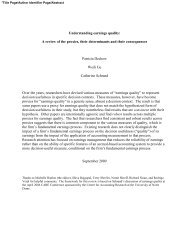Hitting the Tough Shots - MIT Sloan School of Management
Hitting the Tough Shots - MIT Sloan School of Management
Hitting the Tough Shots - MIT Sloan School of Management
You also want an ePaper? Increase the reach of your titles
YUMPU automatically turns print PDFs into web optimized ePapers that Google loves.
Continued from page 5<br />
problem, and want to solve it. Our students want to make a difference, and this want, along with a culture<br />
that ignores barriers is what drives students here to be so entrepreneurial.”<br />
Aulet elaborated on <strong>the</strong> <strong>the</strong>me <strong>of</strong> cross-campus collaboration. “The more collisions <strong>of</strong> great minds we can<br />
create at <strong>MIT</strong> <strong>the</strong> better,” he said. “The <strong>MIT</strong> Entrepreneurship Center, for example, was designed from <strong>the</strong><br />
beginning to serve all fi ve schools across <strong>MIT</strong>, and promote education between <strong>the</strong> schools.”<br />
The <strong>MIT</strong> $100K will start <strong>the</strong> next phase <strong>of</strong> its competition with <strong>the</strong> Executive Summary Contest,<br />
announcing its winners in February 2010, followed by <strong>the</strong> Business Plan Contest, where more than<br />
$350,000 in cash and prizes will be awarded to aspiring entrepreneurs.<br />
For more on <strong>the</strong> <strong>MIT</strong> $100K, please visit: http://www.mit100k.org/<br />
When a Liquidity Diet for Banks Makes Sense<br />
<strong>MIT</strong> <strong>Sloan</strong> researcher’s model tells banks how to avoid running out <strong>of</strong> cash<br />
From <strong>the</strong> <strong>MIT</strong> <strong>Sloan</strong> Media Relations Offi ce<br />
The balance sheets <strong>of</strong> many <strong>of</strong> <strong>the</strong> big banks that failed or teetered on <strong>the</strong> brink in <strong>the</strong> fi nancial crisis<br />
actually looked fi ne. On paper, <strong>the</strong>ir assets were suffi cient to cover liabilities. Their problem was liquidity.<br />
At <strong>the</strong> end <strong>of</strong> each day, banks must have suffi cient liquid assets to meet demands. If <strong>the</strong>y don’t, <strong>the</strong> bank<br />
heads for failure, which is what happened at Bear Stearns and o<strong>the</strong>r Wall Street institutions in <strong>the</strong> fall <strong>of</strong><br />
2008. Liquidity vanished as apprehension about default spread, and banks were afraid to lend to each<br />
o<strong>the</strong>r.<br />
Sebastian Pokutta, a lecturer in operations research and statistics at <strong>MIT</strong> <strong>Sloan</strong>, has developed a<br />
ma<strong>the</strong>matical model that banks can use to organize <strong>the</strong>ir global liquidity operations so <strong>the</strong>y have suffi cient<br />
liquidity to avoid a repeat <strong>of</strong> what happened in <strong>the</strong> crisis.<br />
The model, which Pokutta developed with Christian Schmaltz <strong>of</strong> <strong>the</strong> Frankfurt <strong>School</strong> <strong>of</strong> Finance and<br />
<strong>Management</strong>, tells large banks when <strong>the</strong>y need to open local liquidity centers in outlying subsidiaries.<br />
These centers can generate liquidity almost immediately, while waiting for a transfer from a distant<br />
headquarters can take hours or even be impossible when headquarters is in a different time zone and<br />
happens to be closed at a crucial time.<br />
“A liquidity center provides relatively cheap and immediate liquidity,” Pokutta said. Liquidity centers are<br />
staffed by traders who can quickly execute overnight loans with o<strong>the</strong>r banks or sell <strong>of</strong>f assets to generate<br />
cash when demand is likely to exceed liquid assets.<br />
“If you don’t have a liquidity center in place, <strong>the</strong> only immediate liquidity available is expensive central bank<br />
funds. Cheap liquidity has to be ordered in advance from a distant location and is only available with a<br />
delay.” Pokutta said. “One might say that a liquidity center is an option on cheap and immediate liquidity.”<br />
Opening a liquidity center can be costly for a bank, since staff must be hired, trained, and equipped.<br />
Pokutta’s model identifi es <strong>the</strong> conditions under which opening such a center would be a wise move for<br />
a bank. It turns out that <strong>the</strong> opening <strong>of</strong> a center becomes more attractive when demand uncertainty<br />
increases.<br />
Continued on page 7<br />
6
















